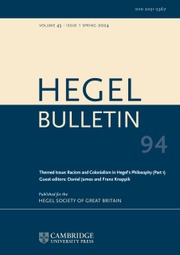No CrossRef data available.
Article contents
Systematicity and Symbolisation in Kant's Deduction of Judgements of Taste
Published online by Cambridge University Press: 06 August 2019
Abstract
Kant's characterisation of judgements of taste, as expressing a disinterested pleasure and as being independent of concepts, defines the framework in which he attempts to justify or ‘deduce’ their claim to universal and necessary validity. In §38 of the Critique of Judgement, the ‘official’ deduction, the problem is to find a balance between the aim of grounding the judgements' validity on their relation to cognition and the danger of collapsing these aesthetic judgements into cognitive ones. Apparently, Kant's intention is to show that even though judgements of taste are not cognitive judgements, they are close enough to the conditions employed in all cognition to legitimize their claim to universal validity. Yet, in §59 of the Dialectic Kant seems to attempt another justification, this time by relating judgements of taste to morality. The problem now is to specify this relation so as to avoid reducing aesthetic to moral judgements. The justificatory projects in §38 and §59 are usually considered to be quite different. My aim in this paper is to clarify the relation between the two projects on the basis of an interpretation of what the pleasurable state of mind consists in, that is, the free harmonious play of the faculties in which everyone ought to share in the presence of beautiful objects. In the light of this interpretation I shall give a reconstruction of the argument of §38 which reveals its connection and contrast with §59.
- Type
- Research Article
- Information
- Bulletin of the Hegel Society of Great Britain , Volume 32 , Issue 1-2: Special Issue on Kant and Hegel , 2011 , pp. 232 - 251
- Copyright
- Copyright © The Hegel Society of Great Britain 2011




